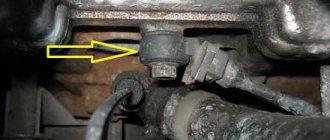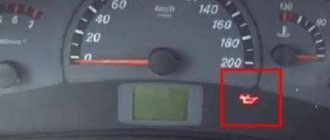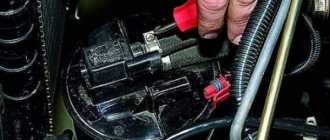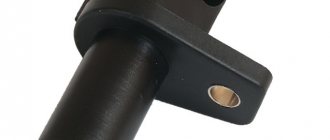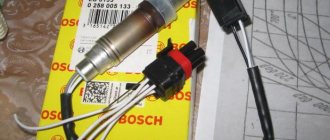The knock sensor (hereinafter referred to as DD) in the VAZ 2110 - 2115 model range is designed to measure the value of the knock coefficient during engine operation.
Where is the DD located: on the cylinder block stud, on the front side. To ensure access for the purpose of prevention (replacement), it is necessary to first dismantle the metal protection.
The dynamics of vehicle acceleration, fuel consumption, and stability of idle speed depend on the technical serviceability of the engine.
How does a knock sensor work?
Car engines can use one of two types of knock sensors: resonant and broadband. But since the first type is already outdated and is rare, we will describe the operation of broadband sensors (WS).
The design of a broadband DD is based on a piezoelectric element, which, when subjected to mechanical action (that is, during an explosion, which, in essence, is detonation), supplies a current with a certain voltage to the electronic control unit. The sensor is configured to perceive sound waves in the range from 6 Hz to 15 kHz. The design of the sensor also includes a weighting agent, which enhances the mechanical effect on it by increasing the force, that is, it increases the sound amplitude.
The voltage supplied by the sensor to the ECU through the connector terminals is processed electronically and then a conclusion is made whether there is detonation in the engine, and accordingly, whether the ignition timing needs to be adjusted, which will help eliminate it. That is, the sensor in this case is only a “microphone”.
Operating principle of DD
The functionality is based on the operation of a piezoelectric element. A piezoelectric plate is mounted inside the DD structure. When detonation occurs, tension is created on the plate. The voltage is not great, but quite enough to create oscillations.
The higher the frequency, the higher the voltage. When fluctuations exceed the maximum range, the electronic control unit automatically adjusts the angle of the ignition system towards a decrease. The ignition is advanced.
When the oscillatory movements disappear, the ignition angle is restored to its original position. Thus, maximum operating efficiency of the power unit is achieved under specific operating conditions.
If the engine fails, the “Check Engine” error appears on the dashboard.
Causes of knock sensor malfunction
As for the reasons why problems arise with the knock sensor, these include the following breakdowns:
- Loss of mechanical contact between the sensor housing and the engine block . As practice shows, this is the most common reason. Typically, the sensor itself has a round shape with a mounting hole in the middle, through which it is attached to its seat using a bolt or pin. Accordingly, if the tightening torque in a threaded connection decreases (the pressing of the motor to the engine is weakened), then subsequently the sensor does not receive sound mechanical vibrations from the cylinder block. In order to eliminate such a breakdown, it is enough to tighten the mentioned threaded connection, or replace the mounting bolt with a mounting pin, since it is more reliable and provides a tight mechanical connection.
- Sensor wiring problems . In this case, there may be various problems, for example, a short circuit of the supply or signal wire to ground, mechanical damage to the wire (especially in places where it is bent), damage to the internal or external insulation, breakage of the entire wire or its individual wires (supply, signal), violation of the shielding braid. In this case, the problem is solved by restoring or replacing its wiring.
- Poor contact at the connection point . This situation sometimes happens if, for example, the plastic latch at the point where the sensor contacts are connected is broken. Sometimes, as a result of shaking, the contact is simply broken, and accordingly, the signal from the sensor or the power to it simply does not reach the recipient. To repair, you can try replacing the chip, correcting the contact, or using another mechanical method to try connecting two pads to the contacts.
- Complete sensor failure . The knock sensor itself is a fairly simple device, so there is nothing special to break there, and accordingly, it rarely fails, but it does happen. The sensor cannot be repaired, so in case of complete breakdown it is necessary to replace it with a new one.
- Problems with the electronic control unit . In the ECU, like any other electronic device, software failures can occur, which leads to incorrect perception of information from the DD, and accordingly, the unit makes incorrect decisions.
It is interesting that when a car owner contacts a car service center with complaints about the operation of the knock sensor, some unscrupulous repairmen immediately offer to replace it with a new one. Accordingly, take more money from the client. Instead, you can try tightening the torque on the sensor threaded mount and/or replacing the bolt with a stud. In many cases this helps.
Is it possible to drive with a faulty knock sensor? This question interests motorists who are encountering this problem for the first time. In general terms, the answer to this question can be formulated as follows: in the short term, you can use the car, but at the earliest possible opportunity, it is necessary to carry out appropriate diagnostics and fix the problem. Indeed, according to the principle of operation of the ECU, when a malfunction of the fuel knock sensor occurs, a late ignition is automatically set to prevent damage to the piston group parts if real detonation occurs during combustion of the fuel mixture. As a result, fuel consumption rises and dynamics drop significantly, which will become especially noticeable as the speed increases.
Diagnosis and problem solving
Begin your diagnosis by visually inspecting all system-related wiring harnesses and connectors. Inspect electrical circuits, sensors, and connectors that are contaminated with engine oil, coolant, or power steering fluid.
Petroleum-based liquids are known to corrode the protective insulation of wires and cause short circuits or open circuits. This may cause the P0327 code to appear.
Sensor test
To test an older style knock sensor, connect a multimeter set to AC voltage between the sensor output wire and ground. Tap the engine near the sensor. You should see the AC voltage reading on your DMM. Otherwise, the sensor is faulty and must be replaced.
To check the resonant type sensor, we connect a digital multimeter in the same way. But instead of knocking on the engine block. The fuel pump relay must be removed to prevent the engine from starting.
Crank the engine, shift into gear, and keep your foot on the brake. As soon as the car starts to run out of fuel, it will start knocking and stalling. You should then see the AC voltage output. Otherwise, the knock sensor is faulty and must be replaced.
Checking electrical circuits
If the knock sensor is working fine but the P0327 code is still on, you need to check the sensor circuit. Using a digital multimeter set to resistance, connect one side of the meter to the harness side of the sensor connector. And the other to the knock sensor input terminal on the PCM. This will check the continuity between the sensor and the PCM.
Now you need to check the grounding. Old style knock sensors are grounded through the sensor itself, while newer style knock sensors usually have a separate ground circuit. Connect the red lead of the multimeter to the positive terminal of the battery and the black lead to ground. You should see a reading of around 12 volts, indicating a good ground. Otherwise, you need to look for a circuit fault.
Signs of a malfunctioning knock sensor
If the DD fails completely or partially, a malfunction of the knock sensor manifests itself according to one of the symptoms:
- Engine shaking . If the sensor and control system in the engine are working properly, this phenomenon should not occur. By ear, the appearance of detonation can be indirectly determined by the metallic sound emanating from a running engine (knock of fingers). And excessive shaking and jerking during engine operation is the first way to determine a malfunction of the knock sensor.
- Reduced power or “dullness” of the engine, which is manifested by deterioration of acceleration or excessive increase in speed at low speeds. This happens when, with an incorrect DD signal, the ignition angle is spontaneously adjusted.
- Difficulty starting the engine , especially “cold”, that is, at low temperatures after a long period of inactivity (for example, in the morning). Although it is quite possible for the car to behave this way even at warm ambient temperatures.
- Increased fuel consumption . Since the ignition angle is disturbed, the air-fuel mixture does not meet optimal parameters. Accordingly, a situation arises when the engine consumes more gasoline than it needs.
- Fixing knock sensor errors. Usually the reasons for their appearance are the signal from the sensor going beyond the permissible limits, a break in its wiring, or a complete failure of the sensor. The occurrence of errors will be indicated by the Check Engine light on the dashboard.
However, it is worth considering that such symptoms may indicate other engine failures, including other sensors. It is recommended to additionally read the ECU memory for errors that could arise due to incorrect operation of individual sensors.
Element diagnostics
It is quite difficult to clearly identify all the signs of a knock sensor malfunction due to the “sleep” operating mode of the element. If you constantly fill the tank with high-quality fuel and carefully operate the car, then you may not find out about a failed device soon.
The main symptom of a malfunction is the appearance of detonation as such. If, when you sharply press the accelerator, a loud knocking sound of the piston pins is heard from the engine, then the electronic control unit no longer adjusts the ignition. Most likely the problem is with the sensor.
The first diagnostic method is carried out “by ear” with a running warm engine in the following sequence:
- Provide access to the element so that it can be touched by hand. If necessary, remove the air filter and pipe.
- Start the engine and leave it running at idle speed of the crankshaft.
- Take a small metal object and gently tap the sensor body while listening to the power unit.
- If knocking on the device causes a change in engine operation, the element is probably working properly. Otherwise, the device must be dismantled to be checked further.
Sometimes a completely working sensor unscrews as a result of vibration and does not fit tightly to the cylinder block, and therefore is unable to detect detonation. Make sure the device is securely fastened before knocking on the case and drawing conclusions.
A more accurate diagnosis is to check the knock sensor with a multimeter. The method is based on the operating principle of the device - the generation of an electrical impulse by a piezoelectric element from the influence of a vibration plate. How to diagnose the problem:
- Disconnect the wiring harness and remove the part from the cylinder block.
- Set the multimeter to measure a maximum voltage of 200 mV and connect the clamps to the sensor terminals.
- Take a small open-end wrench and tap the element body (without fanaticism), observing the display readings.
- Ideally, voltage surges measured in tens of millivolts should be observed. The stronger the impact, the greater the value the working sensor will show. There is no reaction - buy a new spare part.
During the diagnostic process, do not forget about the serviceability of the transmission link - contacts and electrical wiring. If the detonation meter is operational, but you can still hear the sound of your fingers when you press the accelerator, ring the supply cable and clean the oxidized contacts.
A knock sensor (DS) or knock sensor is a device that determines the strength of the detonation nature of fuel combustion in a running engine. It is built into the cylinder block of the internal combustion engine. Thanks to its accurate data, maximum fuel combustion is achieved, which is an indispensable condition for increasing engine power.
What happens if you turn off the knock sensor completely?
Some car owners even try to disable the knock sensor because under normal operating conditions and refueling with good fuel it may seem unnecessary. However, it is not! Because detonation occurs not only due to poor fuel and problems with spark plugs, compression and misfires. Therefore, if you disable the knock sensor, the consequences may be as follows:
- rapid failure (breakdown) of the cylinder head gasket with all the ensuing consequences;
- accelerated wear of elements of the cylinder-piston group;
- cylinder head crack;
- burnout (full or partial) of one or more pistons;
- failure of the jumpers between the rings;
- connecting rod bend;
- burning of valve plates.
This is due to the fact that if this phenomenon occurs, the electronic control unit will not take measures to eliminate it. Therefore, in no case should you turn it off and install a jumper from the resistance, because this is fraught with expensive repairs.
Examination
The sensor can be checked using diagnostics at a service station and using a multimeter. We will consider the second option in detail because of its low cost and independence.
Sensor tester
To check, the sensor must be removed.
- We take a regular multimeter and switch its switch to measure a constant voltage of 200 mV.
- We connect the probes of the device to the sensor and hit the metal part of the sensor with a metal object. The readings on the device should change; if this does not happen, we can conclude that the part is faulty.
DD check
How to determine if a knock sensor is faulty
When the first signs of DD failure appear, a logical question is of interest - how to check and determine the malfunction of the knock sensor. First of all, it must be said that checking the knock sensor is possible without removing it from the cylinder block, or after removing it from its seat. Moreover, first it is better to do several tests when the sensor is screwed to the block. Briefly the procedure looks like this:
- set the idle speed to approximately 2000 rpm;
- With some metal object (small hammer, wrench), apply one or two gentle blows (!!!) to the cylinder block body in the immediate vicinity of the sensor (you can lightly hit the sensor directly);
- if the engine speed drops after this (this will be audible), it means the sensor is working;
- The speed remains at the same level - an additional check needs to be performed.
To check the knock sensor, a car enthusiast will need an electronic multimeter capable of measuring the value of electrical resistance, as well as DC voltage. The best way to check is with an oscilloscope. A diagram of the sensor operation taken with its help will clearly show whether it is operational or not. But since only a tester is available to the average car enthusiast, it is enough to check the resistance readings given by the sensor when tapped. The range of resistance changes is within 400 ... 1000 Ohms. It is also imperative to carry out a basic check of the integrity of its wiring - whether there is a break, damage to the insulation or short circuit. You also cannot do this without the help of a multimeter.
If the check shows that the fuel knock sensor is working properly, but the error indicates that the sensor signal is outside the permissible range, then perhaps it is worth looking for the cause not in the sensor itself, but in the operation of the engine or gearbox. Why? Sounds and vibration are to blame for everything, which the engine can perceive as fuel detonation and incorrectly adjust the ignition angle!
Did not find an answer to your question? Ask in the comments. We will definitely answer!
The engine design has many auxiliary systems and mechanisms. It is impossible to imagine the operation of a power unit without a crankshaft sensor, coolant temperature, throttle position and many other elements. The knock sensor also plays an important role. The VAZ-2110 is also equipped with it. What is this element for? How to check it and why does it fail? We will talk about this in our article today.
Main purpose of the device
A very unpleasant phenomenon is natural explosions in a car engine, which can be caused by uncontrolled and completely spontaneous combustion of diesel fuel. This process takes place in the fuel chamber. But the knock sensor installed in the engine system of a VAZ 2112 or 2110 vehicle controls this process.
Moreover, this device establishes this fact at the initial stage of the process, transmitting the relevant information to the main unit. But the ECU automatically corrects the ignition timing process in order to prevent undesirable consequences. This is how the knock sensor works in the old-style VAZ 2110 car and the newer model installed in the VAZ 2112.
How to change the sensor?
If this element fails, it must be replaced. Fortunately, spare parts for the VAZ-2110 can be found in any store for a low price. A new knock sensor will cost no more than 250 rubles.
How to replace it? First you need to find the element itself. As we said earlier, it is located between the second and third cylinder.
Then, using a 12 mm wrench, unscrew the mounting bolt. Next, you need to press on the plug of the wire clamp and pull it out. Afterwards you can remove the sensor itself.
At the next stage, a new spare part is installed on the VAZ-2110. Having installed the plug with the wires, you should screw back the mounting bolt with a 12mm wrench. At this stage, replacing the knock sensor on the “ten” can be considered complete.
Advertisements on NN.RU – Auto
A specialized company for converting trucks into tow trucks invites you to install a tow truck platform on.
Manufacturing of a broken-type platform with retractable ramps on the GAZ-33023 Gazelle-farmer chassis. Technical characteristics of the tow truck.
With us you can not only extend the frame to fit a body of 5.1 m, 6.2 m, 7.5 m, 9 m for Maz Zubrenok, Maz, Kamaz, Ural, Zil, Mitsubishi, Nissan.
The company offers you to upgrade the Fiat Ducato Fiat Ducato basic version for a solution.
If you heard Dmitry Bykov on the radio, read his columns, books, articles, came to lectures, you do not know him. He is a poet.
